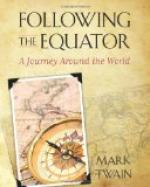The Towers are not tall, but are low in proportion to their circumference, like a gasometer. If you should fill a gasometer half way up with solid granite masonry, then drive a wide and deep well down through the center of this mass of masonry, you would have the idea of a Tower of Silence. On the masonry surrounding the well the bodies lie, in shallow trenches which radiate like wheel-spokes from the well. The trenches slant toward the well and carry into it the rainfall. Underground drains, with charcoal filters in them, carry off this water from the bottom of the well.
When a skeleton has lain in the Tower exposed to the rain and the flaming sun a month it is perfectly dry and clean. Then the same bearers that brought it there come gloved and take it up with tongs and throw it into the well. There it turns to dust. It is never seen again, never touched again, in the world. Other peoples separate their dead, and preserve and continue social distinctions in the grave—the skeletons of kings and statesmen and generals in temples and pantheons proper to skeletons of their degree, and the skeletons of the commonplace and the poor in places suited to their meaner estate; but the Parsees hold that all men rank alike in death—all are humble, all poor, all destitute. In sign of their poverty they are sent to their grave naked, in sign of their equality the bones of the rich, the poor, the illustrious and the obscure are flung into the common well together. At a Parsee funeral there are no vehicles; all concerned must walk, both rich and poor, howsoever great the distance to be traversed may be. In the wells of the Five Towers of Silence is mingled the dust of all the Parsee men and women and children who have died in Bombay and its vicinity during the two centuries which have elapsed since the Mohammedan conquerors drove the Parsees out of Persia, and into that region of India. The earliest of the five towers was built by the Modi family something more than 200 years ago, and it is now reserved to the heirs of that house; none but the dead of that blood are carried thither.
The origin of at least one of the details of a Parsee funeral is not now known—the presence of the dog. Before a corpse is borne from the house of mourning it must be uncovered and exposed to the gaze of a dog; a dog must also be led in the rear of the funeral. Mr. Nusserwanjee Byranijee, Secretary to the Parsee Punchayet, said that these formalities had once had a meaning and a reason for their institution, but that they were survivals whose origin none could now account for. Custom and tradition continue them in force, antiquity hallows them. It is thought that in ancient times in Persia the dog was a sacred animal and could guide souls to heaven; also that his eye had the power of purifying objects which had been contaminated by the touch of the dead; and that hence his presence with the funeral cortege provides an ever-applicable remedy in case of need.




